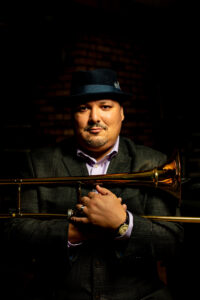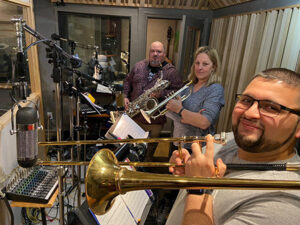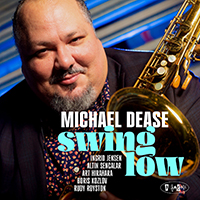
Michael Dease is professor of jazz trombone at Michigan State University. A prolific performer, band leader, composer, and recording artist, his latest release from Posi-Tone records is called Swing Low. It is his first entire recording as a baritone saxophonist.
Renowned trombonist and Michigan State University Professor of Jazz Trombone Michael Dease has released a new album, but it has a twist for his many admirers.
“’Swing Low’ is my first album completely as a saxophonist, my first instrument. I consider it a love letter to myself,” Dease said.
Specifically, it is Dease’s first album as a baritone saxophonist and bandleader. The whole story is told on Dease’s blog, which includes the extensive “Swing Low” liner notes by John Murph, an award-winning journalist who has written for DownBeat, NPR Music, Smithsonian Magazine, and many more. The album for purchase and listening on Bandcamp.
“I’ve played tenor and baritone saxophone before on select tracks over my 25 year career, but this is my first entire album on that instrument,” Dease said.
His return to the instrument came when he and bassist Rodney Whitaker began, director of MSU Jazz Studies, began playing duo bass and baritone saxophone together. Whitaker is credited as an early encourager of documenting this side of Dease’s musicianship.
The album features compositions by musicians that Dease feels strongly deserve wider attention, including Melba Liston, Julian Priester, and Renee Rosnes, as well as emerging talents Virginia MacDonald and Ben Turner. Turner, who earned his Master of Music in Jazz Guitar at MSU in 2023, studying with Randy Napoleon, is a rising star in jazz, according to Dease.
MSU College of Music alum Altin Sencalar, who earned his Master of Music in Jazz Trombone in 2018, played on the album as well. Sencalar plays trombone on three tracks, allowing Dease to focus completely on baritone saxophone.
The musicians recorded all 11 tracks over a six-hour span during one day on February 10, 2023. According to Murph, “Swing Low is the result of the act of reclamation. After nearly two decades of being a top-ranking trombonist, composer, arranger, and bandleader, Michael Dease returns to an instrument that played a crucial role in his artistic trajectory – the baritone saxophone.”
Dease led an excellent ensemble on the recording. They include frequent collaborators, drummer Rudy Royston, trumpeter Ingrid Jensen, pianist Art Hirahara, and bassist Boris Kozlov.

Altin Sencalar (foreground) is a former student of Michael Dease and graduate of the MSU Jazz Studies program. Dease called on his protege to cover trombone while he played saxophone. Trumpeter Ingrid Jensen (center) added to the horn section.
Dease’s musical path began with playing a recorder at age nine in Augusta, Georgia. At age 11, he played alto saxophone in the school concert and symphonic bands. By high school, jazz became his calling, and he moved toward tenor saxophone and trumpet. By age, 17, trombone became his primary instrument.
Still, with all his success as a trombonist, Dease could feel a yearning when he picked up a baritone saxophone. It surprised him at first because his start with the instrument was discouraging, as he explains in the “Swing Low” liner notes.
Dease knew by age 13 that music was his calling. He worked hard to prepare for the high school band auditions because he wanted to be in the school’s top band. Even though he nailed the audition, the band director placed him in the lower level band.
Angered and disappointed, Dease confronted the band director who admitted that, despite having the best audition, he did not want to make a senior student play in the lower level band in their last year. The director eventually allowed Dease into the upper level band, but only if he played baritone saxophone. Dease was devastated by the whole experience, almost to the point of quitting music.

On Swing Low, Michael Dease brings attention to musicians and composers Melba Liston, Julian Priester, and Renee Rosnes, as well as emerging talents Virginia MacDonald and MSU Jazz Studies alum Ben Turner who studied with jazz guitarist Randy Napoleon.
“Music was the place where the playing field could be leveled, and it didn’t matter how expensive your instrument was or how many private lessons your parents could pay for,” Dease explained.
“My parents couldn’t pay for an expensive instrument or private lessons. For me, music was the place where you could work hard and be a part of something greater than yourself. So, when the band director told me that I couldn’t be in the top band even though I had the best audition, it was like a door being slammed in my face.”
The band director’s decision had Dease feeling snubbed, and it led to a long-held disdain for the baritone saxophone. “Swing Low” sheds that disdain for good, and it adds baritone saxophone recording artist to his professional accomplishments, which already include recording on tenor saxophone and, of course, his many accolades as a trombonist.
“For me, the baritone saxophone represented something in life in which you were not being rewarded for your hard work,” Dease explains. “So, it’s crazy for me that almost 30 years later, playing the baritone saxophone feels so right.”
Apparently, listeners agree that it feels right, and the album, on the Posi-Tone label, is garnering a strong reception. As critic Carlo Wolff put it in DownBeat, “This rich, absorbing album effectively blends originals, refreshed classics and tunes by under-recognized composers.”

Through a musical path that began with playing a recorder at age nine in Augusta, Georgia, Michael Dease performs, records, composes, and teaches with great enthusiasm. His success is marked by students leading productive professional lives in music, appreciation from fans and fellow musicians, and accolades from critics.
The entire project has been a personal journey for Dease. He has discovered that even though recording as a baritone saxophonist is new, it is but one part of his life as a musician. The different aspects of that life are starting to meld together, and it strengthens him personally and as an educator. For example, playing both the trombone and baritone saxophone melodically, he explains, comes down to singing with the instrument.
“I teach all my students to sing multiple things like scales, solos, melodies, and tunes,” he states. “It teaches them proper phrasing and the mechanics of using your diaphragm, having proper posture, relaxation, dynamics, control, and nuance. So, from those perspectives, the baritone saxophone and trombone have more in common than differences.”
The success of the “Swing Low” accomplishment leads him to another lesson he can teach his students. It is a lesson about forgiving yourself for the past and continually growing as a musician and as a person.
Playing the baritone saxophone, “has always been like an undiscovered place in my musical life, and I didn’t want it to become a regret. I’m not a fan of regrets, especially when you can do something about them,” he said. “This album is like forgiving myself for ignoring that side of me for so long.”





